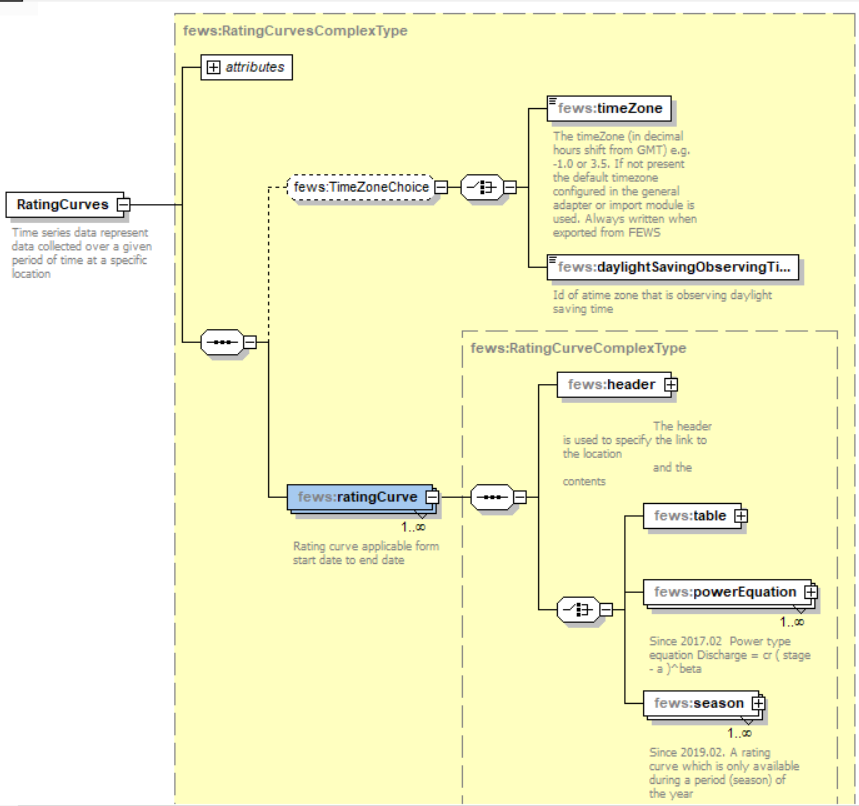What | pi_ratingcurves.xml |
|---|---|
Description | Configuration for rating curves at specific locations |
schema location | https://fewsdocs.deltares.nl/schemas/version1.0/pi-schemas/pi_ratingcurves.xsd |
Configuration
The transformation stageDischarge/ratingCurve uses rating curves according to the schema pi_ratingcurves.xsd.
Rating curves can be stored in the folder RegionConfigFiles in the file RegionConfig.xml , or can be imported in the FEWS database with TimeSeriesImport module, import type “pi_ratingcurves”
Rating Curve schema
The schema of the pi-ratingcurves can be found at: https://fewsdocs.deltares.nl/schemas/version1.0/pi-schemas/pi_ratingcurves.xsd
Header
The header element contains the metadata about the rating curve. Below an overview of the available elements.
- locationId: The location id for which the rating curve is valid
- qualifierId: The allows the configurator to add 1 or more qualifier to the definition of the rating curve. This is useful when for 1 location more rating curves are valid. The locationId and the configured qualifiers define the id of the rating curve.
- startDate: This element defines when the rating curve becomes active.
- endDate: This (optional) element defines until when the rating curve is active.
- longName: Optional descriptive name
- stationName: Optional station name
- stageUnit: Definition of the stage unit
- dischargeUnit: Definition of the discharge unit
- comment: This section allows to define a (optional comment) for the rating curve. If a comment is defined the comment will be shown in the TimeSeriesDialog when viewing the rating curve.
- creationDate: The date on which the rating curve was created.
- creationTime: The time on which the rating curve was created.
- region: The description of the region. This is needed when the id of the rating curve is the same in different regions.
- properties: Optional properties of the rating curve
Table
The table contains the actual description of the Table rating curve.
- InterpolationMethod: Two options are available:linear and logaritmic. When linear is selected the calculation is done by the regular linear method.
The slope will be computed as:
The discharge can be calcuted from the stage by using the following equation:
When the logartimic option is selected the slope will be calculated by:
The discharge can be computed by using the following equation:
The stage can be computed by using the following equation:
When an offset is defined the stage can be calculated by:
minStage
The minimum stage which is allowed for this rating curve. If the minStage is configured as 0.2m and a stage of 0.1m is used as input to calculate a discharge.
than the actual stage used in the calculation will not 0.1m but 0.2m. If the rating curve is used in a discharge to stage calculation and the calculated stage is lower than
the minStage than the calculated stage will be set to the minStage value. If, for example, the minStage is set 0.2m and the calculated stage is equal to 0.1m the
actual calculated stage will be corrected to 0.2m to ensure that no stages lower than minStage are calculated.
This option is usually used to limit the stage value calculated when using extrapolation.
maxStage
The maximum stage which is allowed for this rating curve.
If the maxStage is configured as 5.2m and a stage of 5.5m is used as input to calculate a discharge,
then the actual stage used in the calculation will not be 5.5m but 5.2m. If the rating curve is used in a discharge to stage calculation and the calculated stage is higher than
the maxStage than the calculated stage will be set to the maxStage value. If, for example, the maxStage is set 5.2m and the calculated stage is equal to 5.5m the
actual calculated stage will be corrected to 5.2m to ensure that no stages higher than maxStage are calculated. It is possible to configure the maxStage as INF which means that the
maxStage is set to infinite. Which is the same as defining no maximum stage
row
The row element can be used to define the rows of the stage-discharge table. Each row has a mandatory stage and discharge element. An optional offset can be added.
If a row doesn't include an offset element then the previous defined offset will be used.
powerEquation (Since 2018.02)
PowerEquation can be used as PI Rating cuve since Delft-FEWS version 2018.02.
The powerEquation uses the following equations:
discharge = cr * (stage - alpha)^ beta + Q0
stage = (discharge/cr)^(1/beta) + alpha
where ‘cr’ and ‘beta’ are rating curve constants, ‘alpha’ is a constant which represents the stage corresponding to zero discharge and Q0 is optional shifting constant.
To show the stageToDischargePowerEquation rating curves in the TimeSeriesDisplay, a table is generated on the fly from the power equations.
For each equation ten stage values are generated using increment (max stage – min stage) /10 , and for each stage a discharge is computed. Please note that this table is only used in the display and not in TransformationModule computations.






